

The following is a discussion of considerations pertinent to setting up Inventory within the Abacus 21 System-441.
The examples presented below represent a typical implementation (commenting of F/B and Retail and Other -- but focusing on Food/Beverage)... but may be different from what might be suitable for your particular Installation.
Consult your Abacus 21 Installation Manager for further information on the proper Setups for your Installation.
This segment is divided into the following topics:
Comments about Outlets-Sections-Locations -
Outlets-Sections/Locations are used to identify to the System differentiated physical (or conceptual) areas of operation – a ‘Place’ where things happen.
A ‘place’ is always defined in terms of a combination of an ‘Outlet’ plus a ‘Section/Location’.
Section refers to a place where Items or Services are sold.
Location refers to a place where Items are inventoried.
An area that be defined to be a place that only ‘sells’ (a Section), only ‘inventories’ (a Location), or does both ‘selling and inventory’ (Both).
An Outlet may be sub-divided into multiple Sections and/or Locations.
Food/Beverage operations often involve multiple Outlets… and many of these Outlets involve multiple Sections and/or Locations.
A Retail Outlet (a Store) is usually comprised of only one Section (typically named the same as the Outlet) … unless the Outlet is unusually-large (with multiple sub-areas where the same Item may be stored-and-inventoried or sold).
Items can be ‘stored’ in multiple shelves-bins within Locations… but these normally do not imply separate ‘Inventories’ or ‘requisitions’ amongst them… and are typically treated as an informational ‘Sort-Field’ designation. (Inventory Counts can be sorted (locationally) by this ‘Sort-Field’ – for example within a particular Outlet and Location.)
An 'Administrative' Outlet is often appropriate… as it represents a ‘place’ where Dues, Minimums, Assessments, Loans, and other Items/Services are “sold”. In reality and practice, however:
The above distinctions are oftentimes blurred… but when talking about selling the ‘Section’ word is used… and when talking about inventory the ‘Location’ word is used.
In casual use, the phrase Outlet-Section is normally used.
In very-casual use, the phrase ‘Section’ is oftentimes used by itself (as it almost always uniquely-intuitively implies its associated parent Outlet… and sufficiently denotes the Sales (Section) vs. Inventory (Location) vs. Sales-and-Inventory (both) connotation intended.
For Food/Beverage applications, if multiple Sales areas (Sections) are serviced out of the same (adjoining) Kitchen they are generally grouped under the same Outlet.
An exception to this might be for a central garmaison Kitchen Production Area – that is a separate Outlet… which transfers their mass-produced items to the respective Sales Outlets.
Comments about Distribution-Codes & Accounting (as related to Outlets-Sections-Locations) –
Any ‘Accounting Effects’ associated with things happening at and amongst Outlets-Sections is handled by linking to General Ledger Organization-Account (Chart of Accounts) references.
An ‘Organization’ is a Department or Profit-Center or Cost-Center – including an Organization representing the overall entity [oftentimes where the majority of the Balance-Sheet accounts are housed].
An ‘Account’ is a G/L-Account (created in the Chart-of-Accounts Masterfile) that is separately activated to be in one or more Organizations.
Accounting-References always include the combination of an Organization-Code coupled with an Account.
Both Organizations and Accounts can be alphanumeric – although many Companies only use numeric-architecture.
Accounts can be segmented into sub-Account segments.
Account-Types include Assets, Liabilities, Capital, Revenue, Expense, and Statistical Accounts.
The actual ‘link’ of an Accounting orientation to a particular Outlet-Section-Location is accomplished by what Abacus 21 refers to as a ‘Distribution-Code’.
A Distribution-Code (eg. Food) is created and attached (as pertinent) to one or more Outlets… and then established to be ‘active’ for one or more Sections/Locations of the parent Outlet.
A Distribution-Code provides a means of defining the relevant Accounts available for ‘booking’ Accounting effects pertaining to the Outlet-Section. Types of Distribution-Codes include (designed to tailor the number of Org-Account combination that are pertinent to a particular type of Transaction):
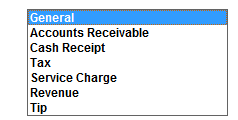
General – Used for Distribution-Codes pertinent to Outlet-Sections-Locations that involve (only) Inventory & Purchasing activities.
Inventory Org-Account
Purchasing Org-Account
Accounts Receivable – Used to define an Accounts-Receivable Account
Accounts-Receivable Org-Account
Cash Receipt – Used to define a Cash Receipts Account
Cash Receipts Org-Account
Tax – Used to define a Tax Account
Tax Org-Account
Service Charge – Used to define a Service-Charge Account
Service-Charge Org-Account
Revenue – Used to define a group of Accounts associated with a Sales and/or Inventory Transaction
Revenue Org-Account
Cost-of-Goods-Sold Org-Account
Inventory Org-Account
Purchases Org-Account
Discount Org-Account (for those Distribution-Codes involving a Customer-type Discount-Type)
Voucher Face-Value Org-Account
Tip – Used to define a Tip/Gratuity (vis-à-vis Service-Charge, the “discretionary” portion) Account
Tip Org-Account
General Ledger Setups (GLD) –
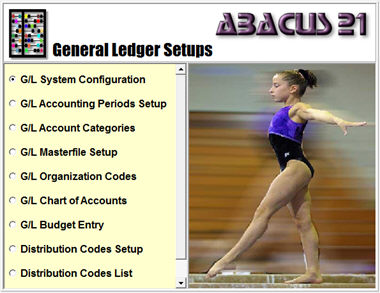
G/L Configuration (GLD-GLSC) -
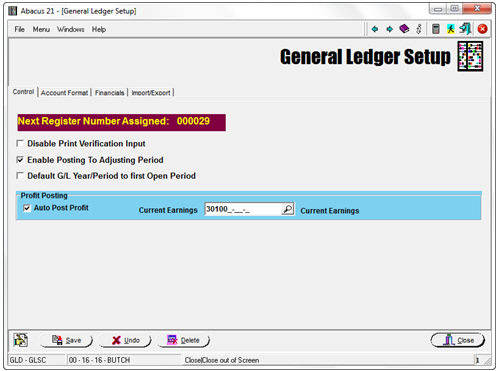
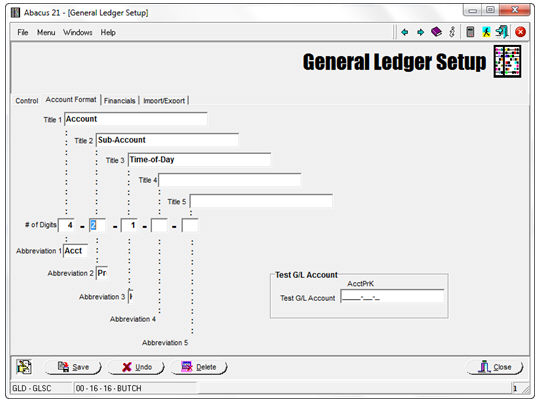
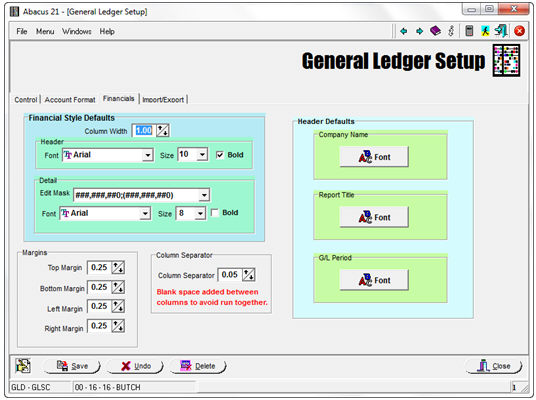
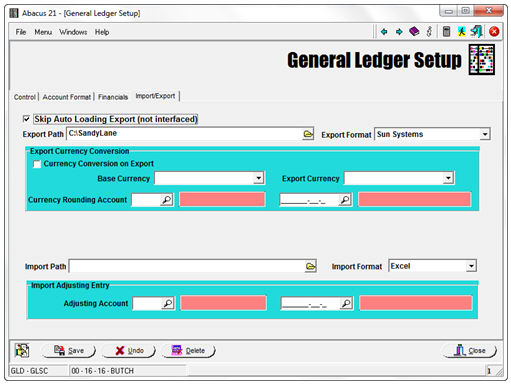
G/L Account Periods Setup (GLD-AP) –
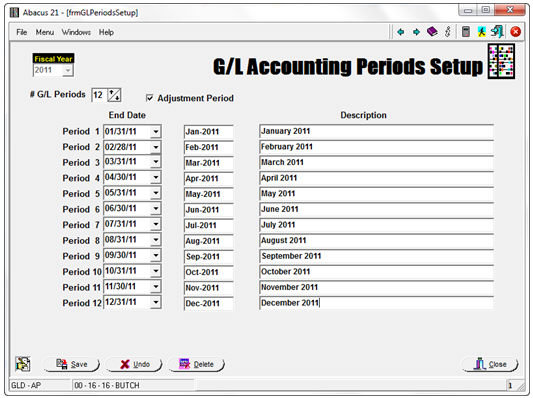
G/L Account Category Setup (GLD-AC) – for alternate lookups (up to three per Account)
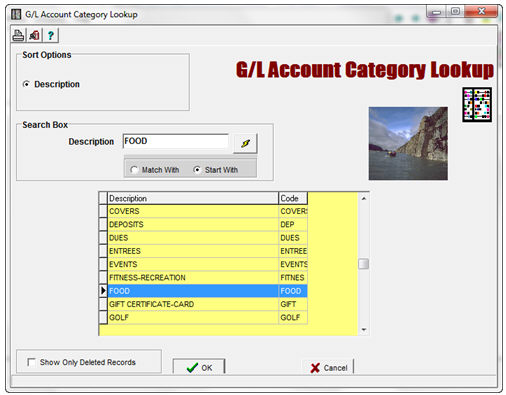
G/L Master Accounts Setup (GLD-GLM) –
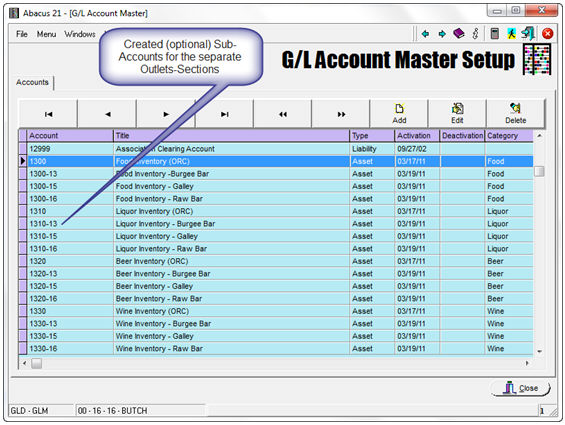
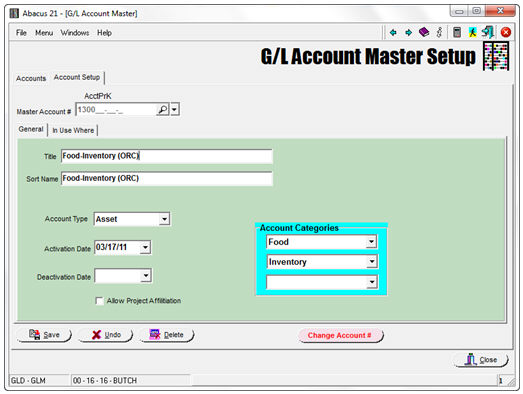
Organization Codes (GLD-OC) – Create Organization-Codes & Assign (activate) Master Accounts to them
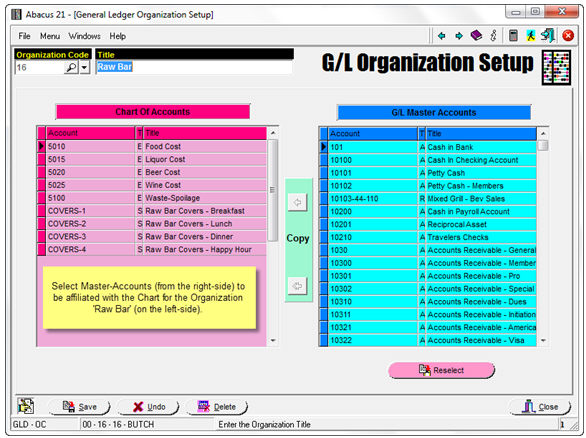
Adding Accounts (optional Sub-Accounts of Inventory – per Outlet) to Organization ‘00’ (eg. Ocean Reef Club):
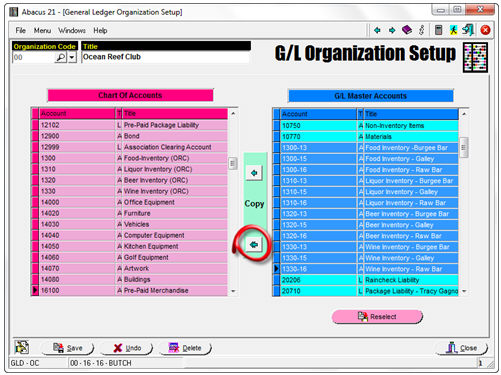
… and the result:
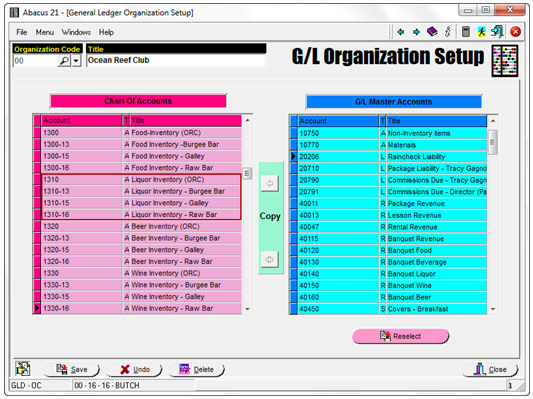
Chart of Accounts Setup (GLD-CA) –
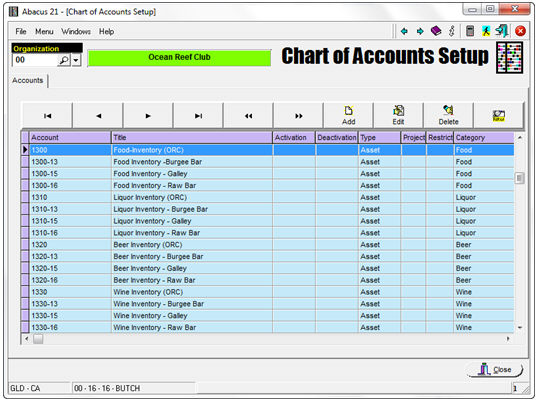
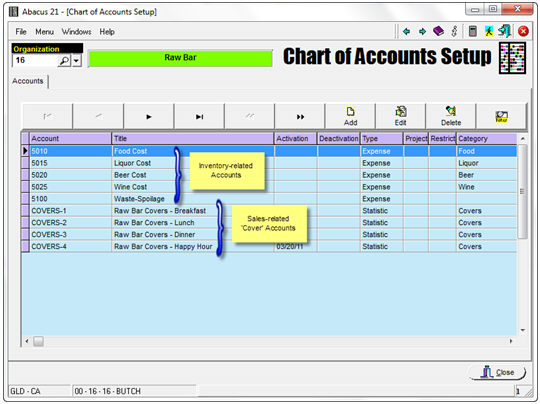
Personalization of an Account Title (for a specific Organization) –
Below is the ‘generic’ Description of the Account-Title:
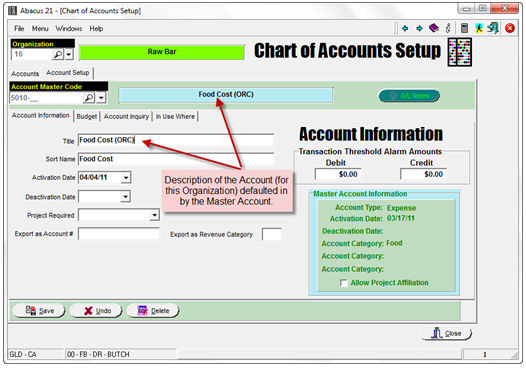
The Account Title can be ‘personalized’ for its use in a particular Organization (such as the Raw Bar):
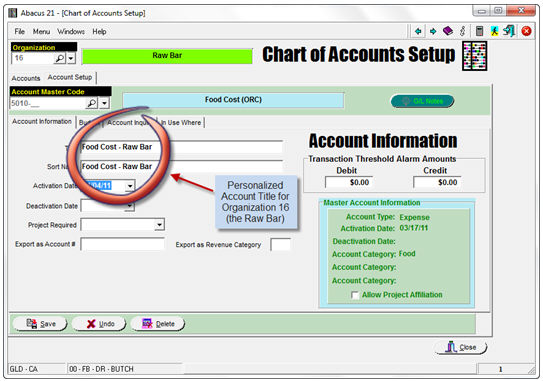
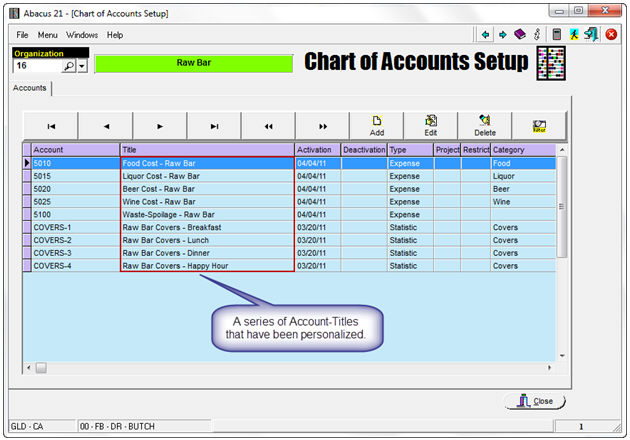
G/L Budget Setup (GLD-BS) –
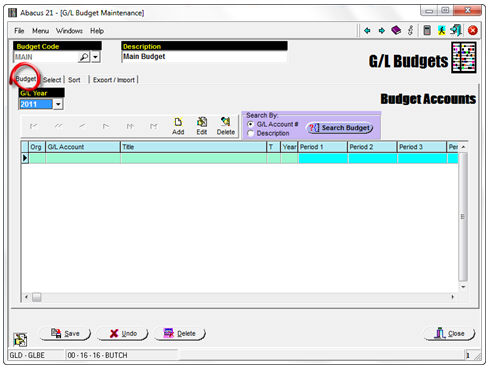
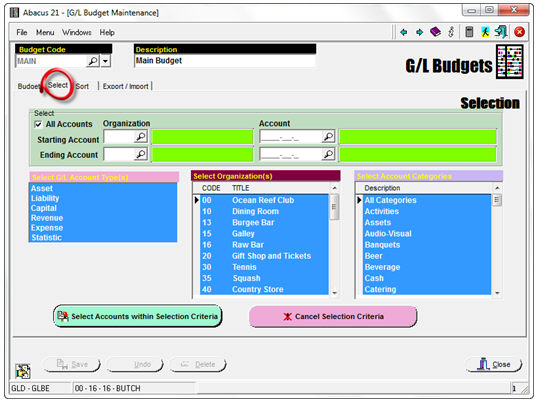
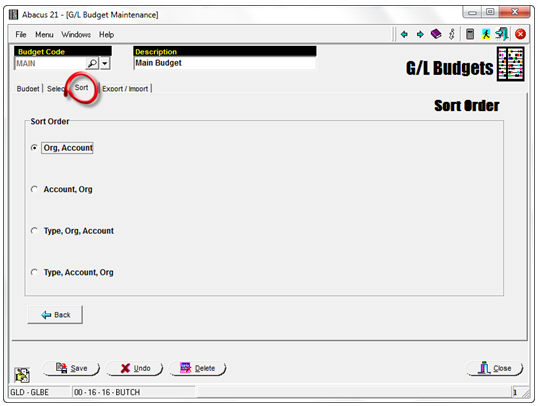
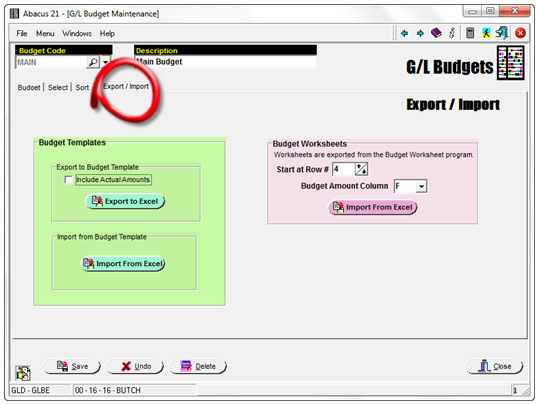
Distribution Codes (GLD-DCM) –
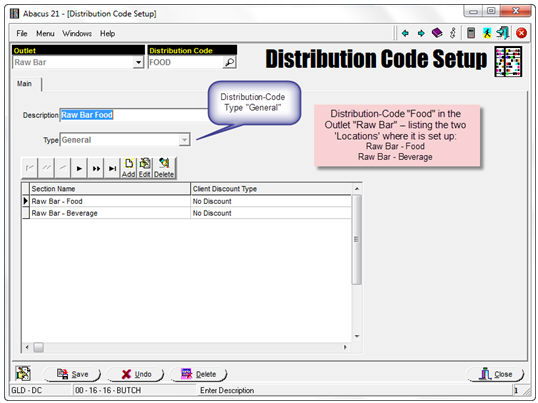
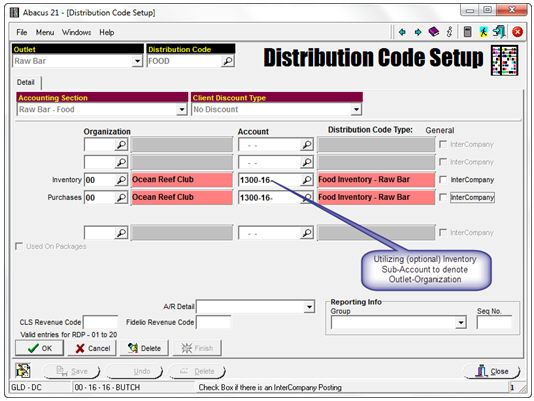
Below is an example of Wine set up for another Outlet (13 = Burgee Bar):
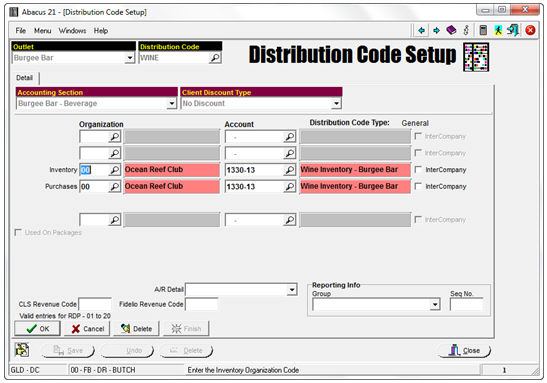
Below is an example of Wine set up for another Outlet (15 = Galley):
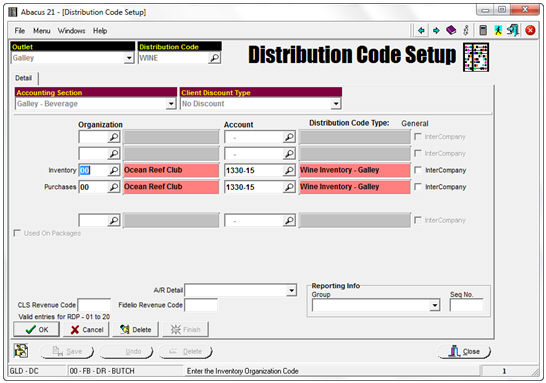
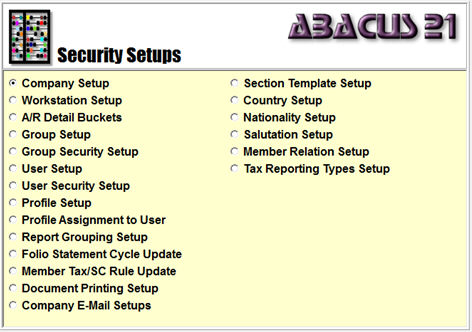
Company Maintenance (SEC-CS) -
Set up the Outlets-Sections/Locations - Sample of an Inventory-oriented Outlet (broken down into multiple Locations):
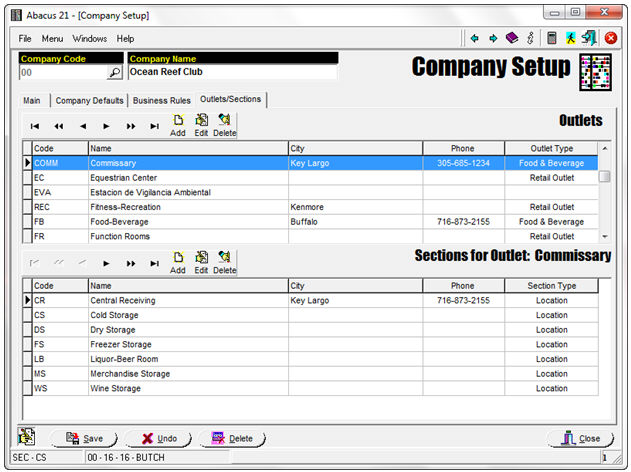
Setup for an Outlet -
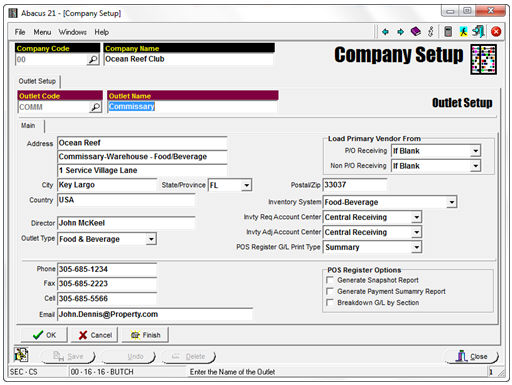
Setup for a Location -
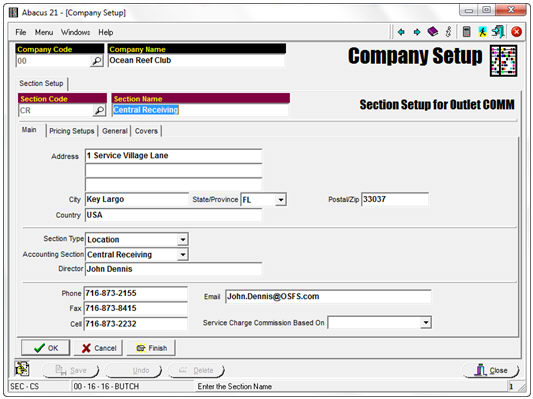
Sample of a Sales-oriented Outlet –
This Outlet is broken down into the principal Sales area (‘Raw Bar’) and two related Inventory area (‘Raw Bar – Beverage’ and ‘Raw Bar – Food’).
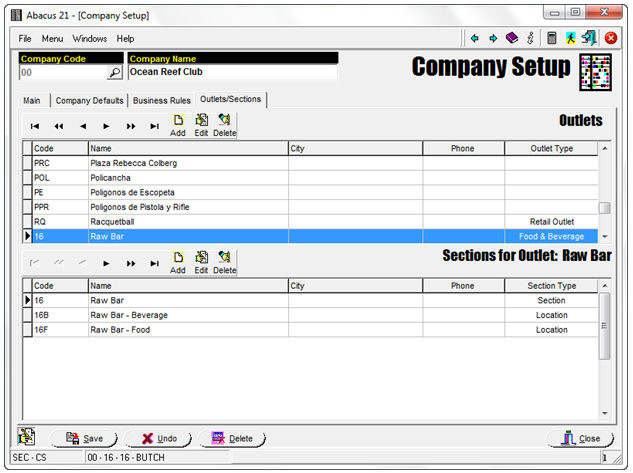
Note: For the purposes of the Demo Database, the ‘Beverage’ and ‘Food’ Locations has been named with the principal Outlet’s “Raw Bar” designation preceding the Food vs. Beverage differentiation… to put the overall search in Outlet-order (rather than Food vs. Beverage order).
The Raw Bar Outlet – Maintenance Screen:
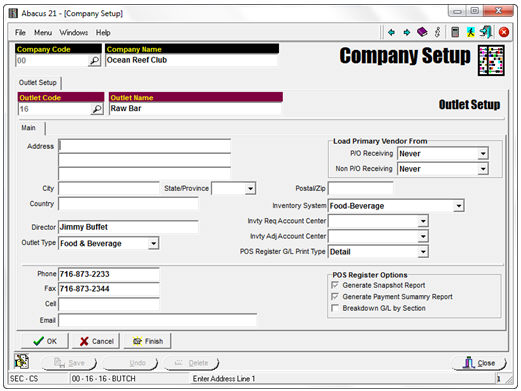
The Raw Bar Section – ‘Main’ Tab:
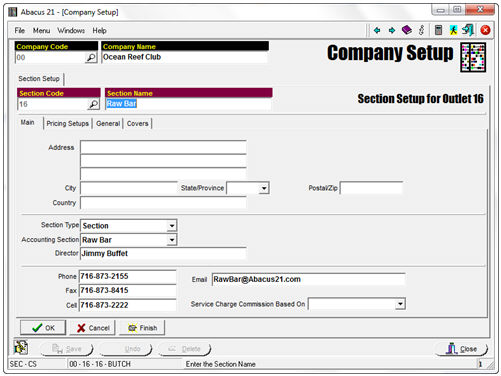
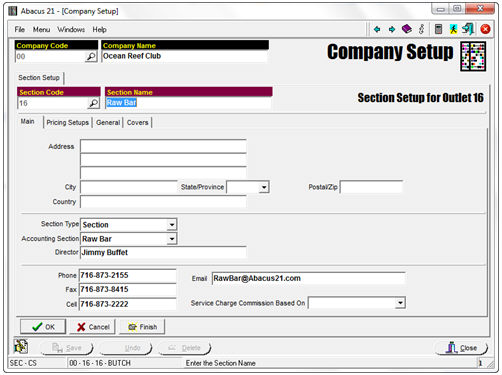
The Raw Bar Section – ‘Price Setups’ Tab (if doing Point-of-Sale):
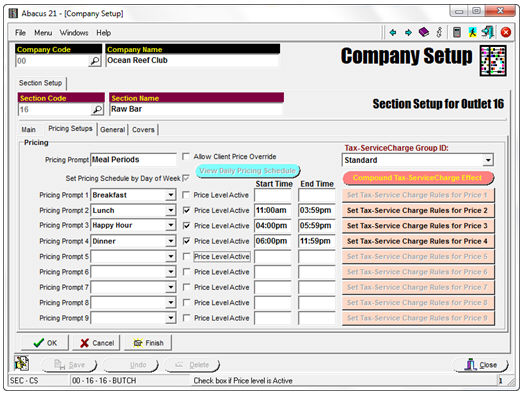
The Raw Bar Section – ‘Covers’ Tab (if doing Point-of-Sale):
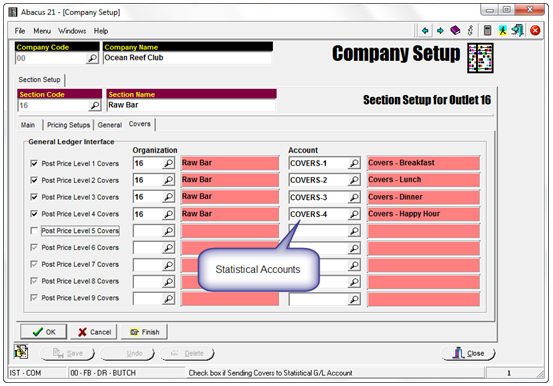
Inventory Setups (IN4) –
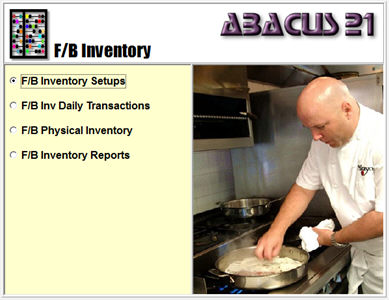
Inventory Setups (IN4-IIS) --
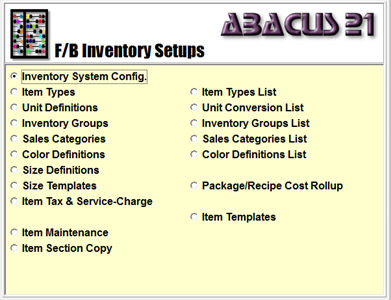
Inventory System Configuration (IIS-ISC) –
Inventory Systems are established to (completely) segregate separate types of Inventories. Any Inventory, Purchasing, or Point-of-Sale activities within an Inventory System is completely self-contained – and these types of Transactions cannot cross Inventory Systems.
An Item cannot ‘cross’ Inventory Systems. In order to (artificially) “transfer” an Item between Inventory Systems, you have to Transfer-Expense it out of the original Inventory System… and “receive” it into the other Inventory System.
The same Item that exists in another Inventory System needs to be set up independently in that other Inventory System.
The same Item-Code can have dissimilar connotations in different respective Inventory Systems.

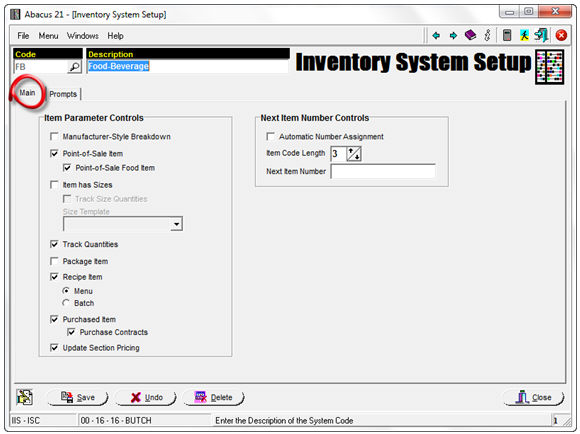
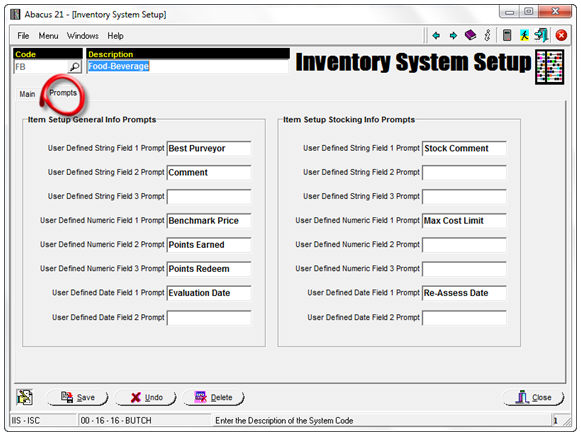
Inventory Types (IIS-IT) –
This are broad classifications of Inventory (that will be used within an Inventory System)… for the purposes of separating Inventory (eg., for Physical Counting purposes):
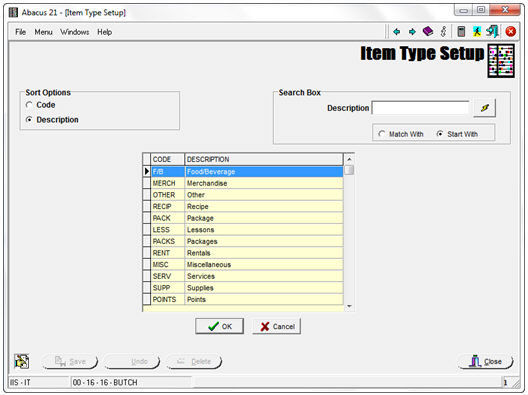
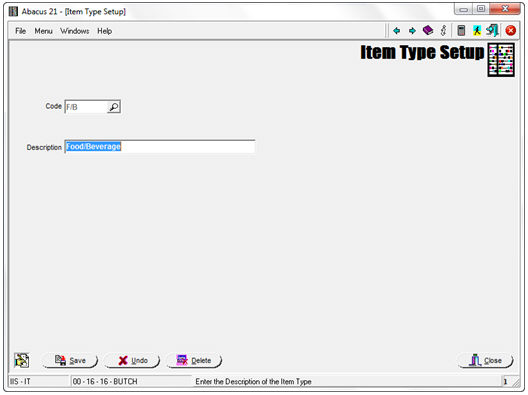
Units of Measure (IIS-UM) –
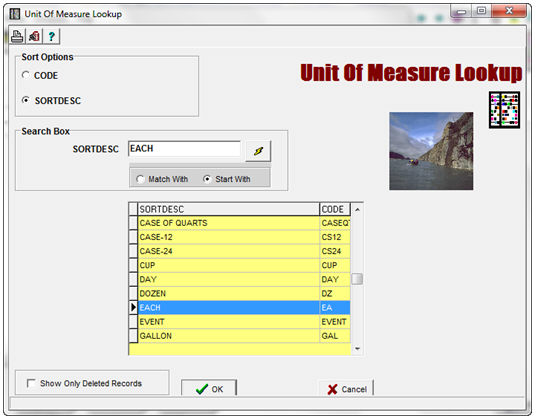
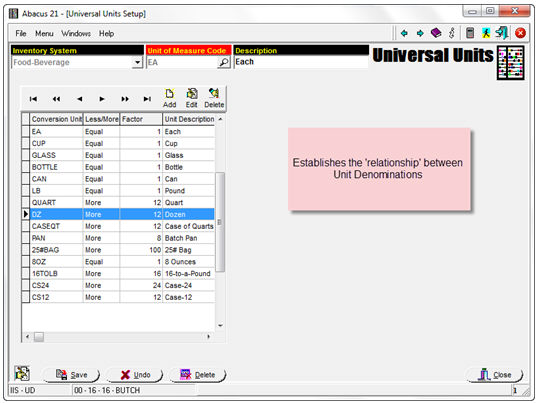
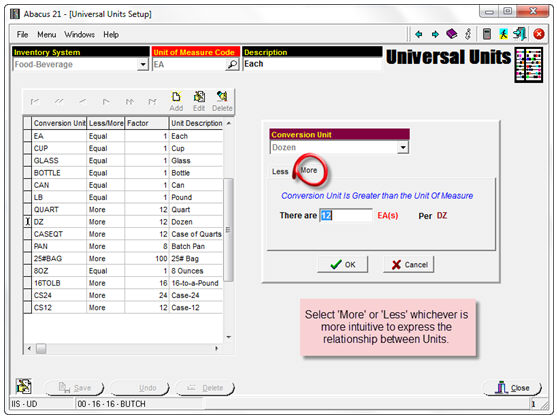
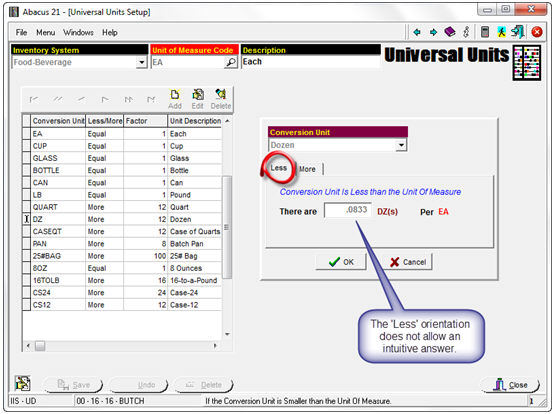
Inventory Groups (IIS-IG) –
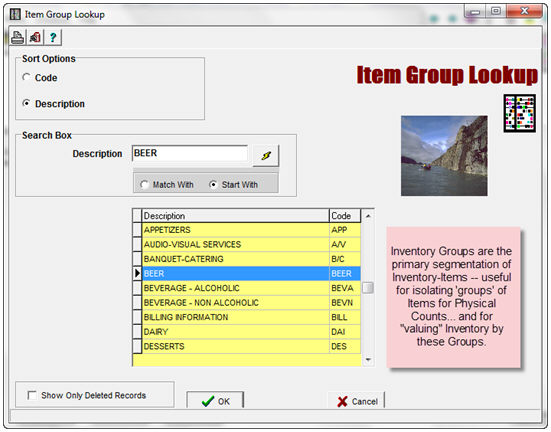
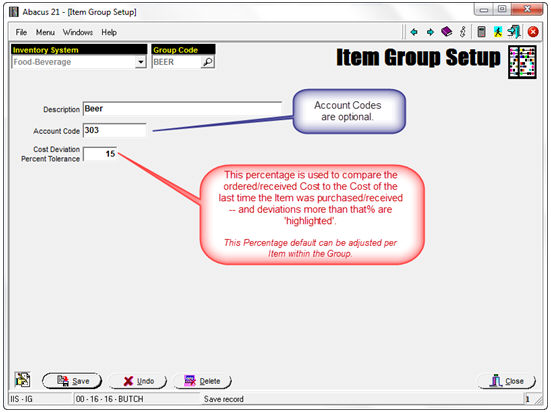
Item Maintenance (IIS-IM) –
The Item – as established in the Inventory-System in general:
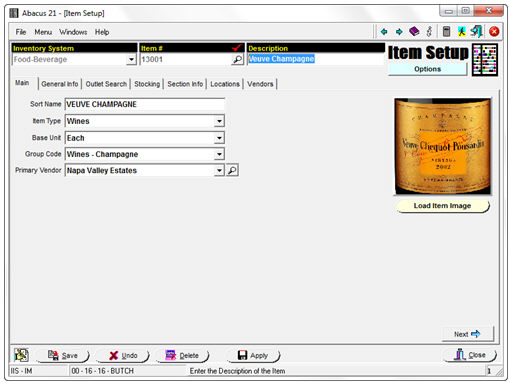
The Item – as established in an Outlet (the Commissary):
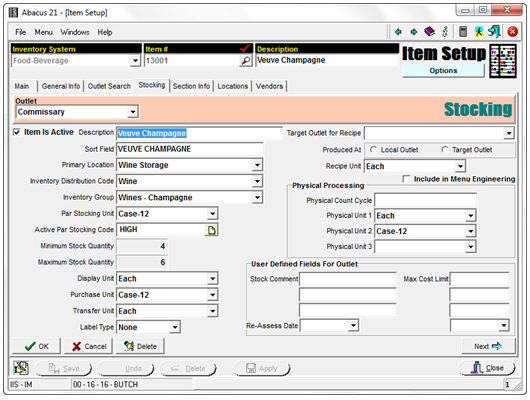
The Item – as established in an Outlet (the Raw Bar):
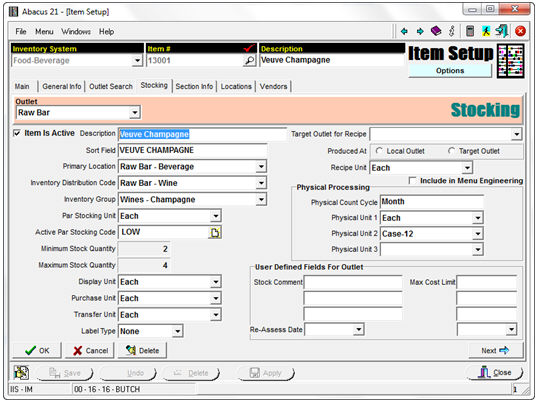
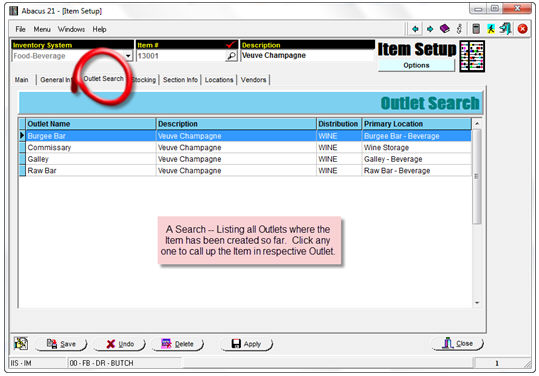
Note: An Item may be in more than one Section/Location of a specific Outlet; the ‘Primary ‘Location’ (in the respective Outlet) is listed above.